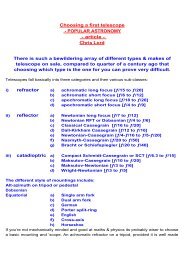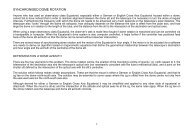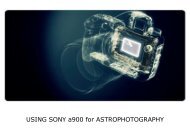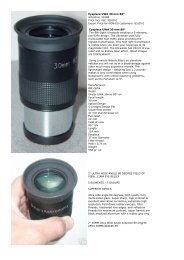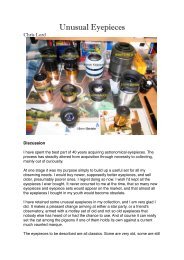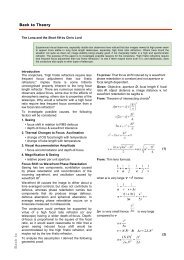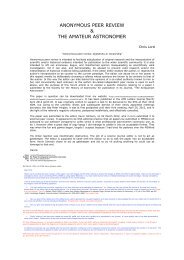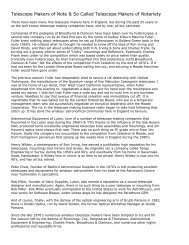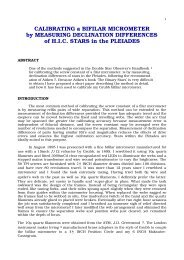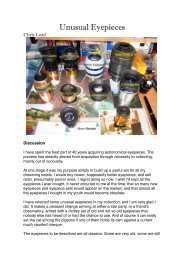Evolution of the Astronomical Eyepiece - Brayebrook Observatory
Evolution of the Astronomical Eyepiece - Brayebrook Observatory
Evolution of the Astronomical Eyepiece - Brayebrook Observatory
Create successful ePaper yourself
Turn your PDF publications into a flip-book with our unique Google optimized e-Paper software.
THE EVOLUTION OF<br />
EYEPIECE DESIGN<br />
EVOLUTION <strong>of</strong> <strong>the</strong> ASTRONOMICAL EYEPIECE<br />
Having looked at <strong>the</strong> succession <strong>of</strong> eyepiece<br />
designs over <strong>the</strong> past four centuries,<br />
it is easy to recognize <strong>the</strong> evolution<br />
in thinking that lies behind each<br />
stage <strong>of</strong> development.<br />
Huyghens’ concept <strong>of</strong> a field lens to reduce<br />
<strong>the</strong> focal length <strong>of</strong> <strong>the</strong> objective<br />
and enlarge <strong>the</strong> apparent field <strong>of</strong> view,<br />
and at <strong>the</strong> same time correct lateral<br />
colour and minimize spherical aberration,<br />
set <strong>the</strong> stage and dictated all<br />
thinking upon <strong>the</strong> subject until 1977<br />
and <strong>the</strong> first computer auto-optimized<br />
design.<br />
Ramsden’s concept placed a flat focal<br />
plane, corrected for rectilinear distortion,<br />
in an accessible position. For <strong>the</strong><br />
first time micrometer threads could be<br />
seen clearly, and not marred by spherical<br />
aberrati on and fa lse colou r.<br />
Ramsden’s concept has set <strong>the</strong> stage<br />
for all eyepiece designs intended for<br />
micrometers, comparators and sighting<br />
telescopes.<br />
Kellner’s achromatic eyepiece was<br />
essentially an achromatized Ramsden.<br />
Altering <strong>the</strong> plano-convex field lens to a<br />
bi-convex, and over-correcting <strong>the</strong> eye<br />
doublet to compensate, resulted in a<br />
wider apparent fiel d th an <strong>the</strong><br />
Huyghenian, with greater eye relief.<br />
Plössl’s develo pmen t <strong>of</strong> <strong>the</strong><br />
Symmetrical, Dial-Sight and assymetric<br />
Plössl followed from h is earlier<br />
designs <strong>of</strong> camera objectives and an<br />
i m p roved achromatic and apla natic<br />
doublet. Zeiss’ Abbé duplet, with <strong>the</strong><br />
later addition <strong>of</strong> an optional field lens,<br />
led naturally to <strong>the</strong> wide angle Erfles<br />
and <strong>the</strong>ir derivatives.<br />
Abbé’s Orthoscopic eyepiece was truly<br />
innovative, <strong>the</strong>re being nothing to base<br />
it on. It is ironic that this design, in its<br />
best forms, remains <strong>the</strong> most useful<br />
a s t ronomica l eyepiece for genera l<br />
observation.<br />
42<br />
König’s design was at first called <strong>the</strong><br />
Kellner II, and it is obviously a variation<br />
<strong>of</strong> <strong>the</strong> Kellner. König worked with<br />
Bertele, and <strong>the</strong> König II and Bertele<br />
designs ar e conceptual extensions <strong>of</strong><br />
König’s initial work.<br />
It i s not dif ficu lt to recognize <strong>the</strong><br />
desi gn de vel opment <strong>of</strong> <strong>the</strong> Zeiss<br />
A s t ro p l a n o k u l a r. Post W. W. I I<br />
a s t r onom ical eyep iece desi gn experienced<br />
a ma rked d ow n-tur n du e<br />
to mil itary su rplus satura ting <strong>the</strong><br />
ma rket wi th Orthoscopi c, Kellner,<br />
Symm etrical, Dia l-Sight, and Erf l e<br />
types a t prices which undercut all<br />
commercial design and manufacturing<br />
costs. It was only when this surplus<br />
market dried up in <strong>the</strong> mid to late<br />
1970’s that commercial astronomical<br />
eyepiece design began to increase once<br />
more. Even so auctioned military eyepieces<br />
ar e still being <strong>of</strong>fered, many <strong>of</strong><br />
<strong>the</strong>m Galoc wide angle designs, developed<br />
during <strong>the</strong> 1930’s from <strong>the</strong> work<br />
<strong>of</strong> Er flé.<br />
It is unfortunate that all <strong>the</strong> modern<br />
computer optimized ultra-wide angle<br />
designs, post Fleischman, share <strong>the</strong><br />
same 8 to 10 air-glass surfaces, and<br />
adopt <strong>the</strong> negative-positive in many<br />
instances too, which introduces excessive<br />
rectilinear distortion.<br />
The first true wide angle design was <strong>the</strong><br />
Erflé, and to date, <strong>the</strong> only significant<br />
impr ovement has been <strong>the</strong> Galoc II and<br />
<strong>the</strong> Bertele-Galoc hybrid, which combine<br />
<strong>the</strong> better features <strong>of</strong> both <strong>the</strong><br />
Erflé and <strong>the</strong> Orthoscopic. Greenwood<br />
has fabricated an excellent 1-2-1 wide<br />
angle design called <strong>the</strong> Panscopic, in<br />
which <strong>the</strong> collecting doublet is severely<br />
over-corrected and almost zero power.<br />
This empirical design is superior to <strong>the</strong><br />
König, yielding a highly corrected 70˚<br />
field. A similar 1-2-2 ultra-wide angle<br />
called <strong>the</strong> Platyscopic <strong>of</strong> fers similar<br />
per formance to <strong>the</strong> Galoc.



